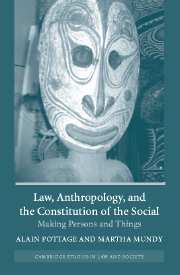14 results
10 - Finding Melanesia in Ancient Rome: Mauss’ Anthropology of nexum
-
-
- Book:
- Roman Law before the Twelve Tables
- Published by:
- Edinburgh University Press
- Published online:
- 22 September 2020
- Print publication:
- 31 March 2020, pp 171-198
-
- Chapter
- Export citation
9 - Our Geological Contemporary
- from Part I - Histories of the Legal Contemporary
-
-
- Book:
- Searching for Contemporary Legal Thought
- Published online:
- 28 December 2017
- Print publication:
- 28 December 2017, pp 177-196
-
- Chapter
- Export citation
Contributors
-
-
- Book:
- Concepts of Property in Intellectual Property Law
- Published online:
- 05 October 2013
- Print publication:
- 26 September 2013, pp viii-ix
-
- Chapter
- Export citation
1 - On the prehistory of intellectual property
- from Part I - Intellectual property as property?
-
-
- Book:
- Concepts of Property in Intellectual Property Law
- Published online:
- 05 October 2013
- Print publication:
- 26 September 2013, pp 11-28
-
- Chapter
- Export citation
Fabled Animals - Review of Michel Serres (translated by Lawrence R. Schehr) The parasite. Minneapolis, University of Minnesota Press, 2007, pp. xxviii + 255. (All page references are to the French edition of Le parasite. Paris: Hachette, 1997.)
-
- Journal:
- BioSocieties / Volume 3 / Issue 4 / December 2008
- Published online by Cambridge University Press:
- 01 December 2008, pp. 452-455
- Print publication:
- December 2008
-
- Article
- Export citation
Too Much Ownership: Bio-prospecting in the Age of Synthetic Biology
-
- Journal:
- BioSocieties / Volume 1 / Issue 2 / June 2006
- Published online by Cambridge University Press:
- 23 July 2016, pp. 137-158
- Print publication:
- June 2006
-
- Article
- Export citation
1 - Introduction: the fabrication of persons and things
-
-
- Book:
- Law, Anthropology, and the Constitution of the Social
- Published online:
- 12 July 2009
- Print publication:
- 24 June 2004, pp 1-39
-
- Chapter
- Export citation
9 - Our original inheritance
-
-
- Book:
- Law, Anthropology, and the Constitution of the Social
- Published online:
- 12 July 2009
- Print publication:
- 24 June 2004, pp 249-285
-
- Chapter
- Export citation

Law, Anthropology, and the Constitution of the Social
- Making Persons and Things
-
- Published online:
- 12 July 2009
- Print publication:
- 24 June 2004
Notes on contributors
-
-
- Book:
- Law, Anthropology, and the Constitution of the Social
- Published online:
- 12 July 2009
- Print publication:
- 24 June 2004, pp viii-x
-
- Chapter
- Export citation
Bibliography
-
-
- Book:
- Law, Anthropology, and the Constitution of the Social
- Published online:
- 12 July 2009
- Print publication:
- 24 June 2004, pp 286-301
-
- Chapter
- Export citation
Index
-
- Book:
- Law, Anthropology, and the Constitution of the Social
- Published online:
- 12 July 2009
- Print publication:
- 24 June 2004, pp 302-310
-
- Chapter
- Export citation
Contents
-
- Book:
- Law, Anthropology, and the Constitution of the Social
- Published online:
- 12 July 2009
- Print publication:
- 24 June 2004, pp vii-vii
-
- Chapter
- Export citation
Frontmatter
-
- Book:
- Law, Anthropology, and the Constitution of the Social
- Published online:
- 12 July 2009
- Print publication:
- 24 June 2004, pp i-vi
-
- Chapter
- Export citation



